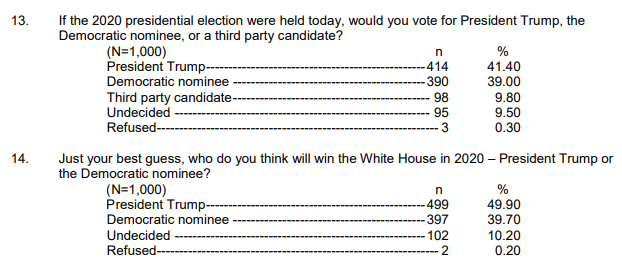In addition to the caveat about the Electoral College, polls can change pretty fast. Just on Oct 30, another predicted Trump would win the popular vote, against an unnamed Democratic nominee, by a narrow margin. Even more noteworthy, the subjects gave an even higher rating to Trump's chance of actually winning the race (probably because people are aware of issues like the Electoral College and swing states):

The poll surveyed 1,000 registered voters across the country from October 23 to October 26 and has a margin of error of 3 percentage points. The findings of the poll were released on Wednesday, October 30.
And that poll is from a fairly reliable pollster (Suffolk University) as well (A- rating on 538).
Additionally, there can be large differences between well-rated pollsters on seemingly very similar questions.
And NYT had a much more sensible take (than the OP's question seems to suggest) on the latest polls (published Nov 4-5)
In national polls, Mr. Trump’s political standing has appeared to be in grave jeopardy. His approval ratings have long been in the low 40s, and he trails Mr. Biden by almost nine points in a national polling average. But as the 2016 race showed, the story in the battleground states can be quite different. Mr. Trump won the election by sweeping Michigan, Pennsylvania, Wisconsin, Florida, Arizona and North Carolina — even while losing the national vote by two points.
Democrats would probably need to win three of the six states to win the White House, assuming other states voted as they did in 2016 — an outcome that is not at all assured.
The Times/Siena results and other data suggest that the president’s advantage in the Electoral College relative to the nation as a whole remains intact or has even grown since 2016, raising the possibility that the Republicans could — for the third time in the past six elections — win the presidency while losing the popular vote.
There is a full year before Election Day, and a lot can change. [...]


AAPOR which did an extensive post-hoc evaluation of the 2016 polling (fiasco) noted that state-level polling, which matters a lot in the final outcome, was rather unreliable in 2016 in part due to poor sampling compesation and in part due to apparently last-minute decision making by undecieded voters.
National polls were generally correct and accurate by historical standards. [...]
[However] State-level polls showed a competitive, uncertain contest… …but clearly under-estimated Trump’s support in the Upper Midwest.
In the contest that actually mattered, the Electoral College, state-level polls showed a competitive race in which Clinton appeared to have a slim advantage. Eight states with more than a third of the electoral votes needed to win the presidency had polls showing a lead of three points or less (Trende 2016). As Sean Trende noted, “The final RealClearPolitics Poll Averages in the battleground states had Clinton leading by the slimmest of margins in the Electoral College, 272-266.” The polls on average indicated that Trump was one state away from winning the election.
Polls showed Hillary Clinton leading, if narrowly, in Pennsylvania, Michigan and Wisconsin, which had voted Democratic for president six elections running. Those leads fed predictions that the Democratic Blue Wall would hold. Come Election Day, however, Trump edged out victories in all three. [...]
Many polls – especially at the state level – did not adjust their weights to correct for the over-representation of college graduates in their surveys, and the result was over-estimation of support for Clinton. [...]
About 13 percent of voters in Wisconsin, Florida and Pennsylvania decided on their presidential vote choice in the final week, according to the best available data. These voters broke for Trump by near 30 points in Wisconsin and by 17 points in Florida and Pennsylvania.
While pollsters may be able to fix the sampling compensation issue for [less] educated voters, it's a lot less clear if they can do anything about the last-minute-decision voters.


